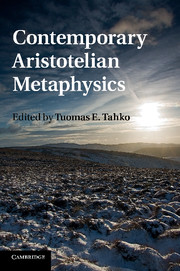Book contents
- Frontmatter
- Contents
- Contributors
- Preface
- Introduction
- Chapter 1 What is metaphysics?
- Chapter 2 In defence of Aristotelian metaphysics
- Chapter 3 Existence and quantification reconsidered
- Chapter 4 Identity, quantification, and number
- Chapter 5 Ontological categories
- Chapter 6 Are any kinds ontologically fundamental?
- Chapter 7 Are four categories two too many?
- Chapter 8 Four categories – and more
- Chapter 9 Neo-Aristotelianism and substance
- Chapter 10 Developmental potential
- Chapter 11 The origin of life and the definition of life
- Chapter 12 Essence, necessity, and explanation
- Chapter 13 No potency without actuality: the case of graph theory
- Chapter 14 A neo-Aristotelian substance ontology: neither relational nor constituent
- References
- Index
Chapter 13 - No potency without actuality: the case of graph theory
Published online by Cambridge University Press: 05 December 2011
- Frontmatter
- Contents
- Contributors
- Preface
- Introduction
- Chapter 1 What is metaphysics?
- Chapter 2 In defence of Aristotelian metaphysics
- Chapter 3 Existence and quantification reconsidered
- Chapter 4 Identity, quantification, and number
- Chapter 5 Ontological categories
- Chapter 6 Are any kinds ontologically fundamental?
- Chapter 7 Are four categories two too many?
- Chapter 8 Four categories – and more
- Chapter 9 Neo-Aristotelianism and substance
- Chapter 10 Developmental potential
- Chapter 11 The origin of life and the definition of life
- Chapter 12 Essence, necessity, and explanation
- Chapter 13 No potency without actuality: the case of graph theory
- Chapter 14 A neo-Aristotelian substance ontology: neither relational nor constituent
- References
- Index
Summary
Introduction
Dispositional essentialism is the thesis that at least some characteristics or properties of objects are dispositional in nature. What this means is that the essence of a dispositional property (disposition for short) is its relation to other properties, namely the stimulus and manifestation properties of the disposition. To take the stock example of fragility, and speaking loosely, the essence of this disposition is its relation to the stimulus of being (appropriately) stressed and the manifestation or response to the stimulus, which consists in breaking. A glass that possesses fragility will, if appropriately stressed, break. A more precise example is solubility: any solid, liquid, or gas that has the disposition of solubility in a liquid L will, when inserted into L, dissolve to form a homogeneous solution with L.
Dispositional essentialists generally allow that not all properties are dispositional, though how to mark the distinction between the dispositional and the non-dispositional, and what it means to be a non-dispositional property, are vexed issues. (See Molnar 2003: chapter 10 for an interesting discussion.) Alexander Bird (2007), however, argues for a stronger thesis, namely dispositional monism: this is the view that all properties have dispositional essences. More precisely, he argues that at the ‘fundamental level’, all properties are essentially dispositional. The fundamental level is that of properties with ‘non-redundant causal powers’ (13) which (together with the objects that possess them – presumably a subset of the objects of physics) generate all of the natural laws upon which supervene all other objects, properties, and laws found in nature.
- Type
- Chapter
- Information
- Contemporary Aristotelian Metaphysics , pp. 207 - 228Publisher: Cambridge University PressPrint publication year: 2011

